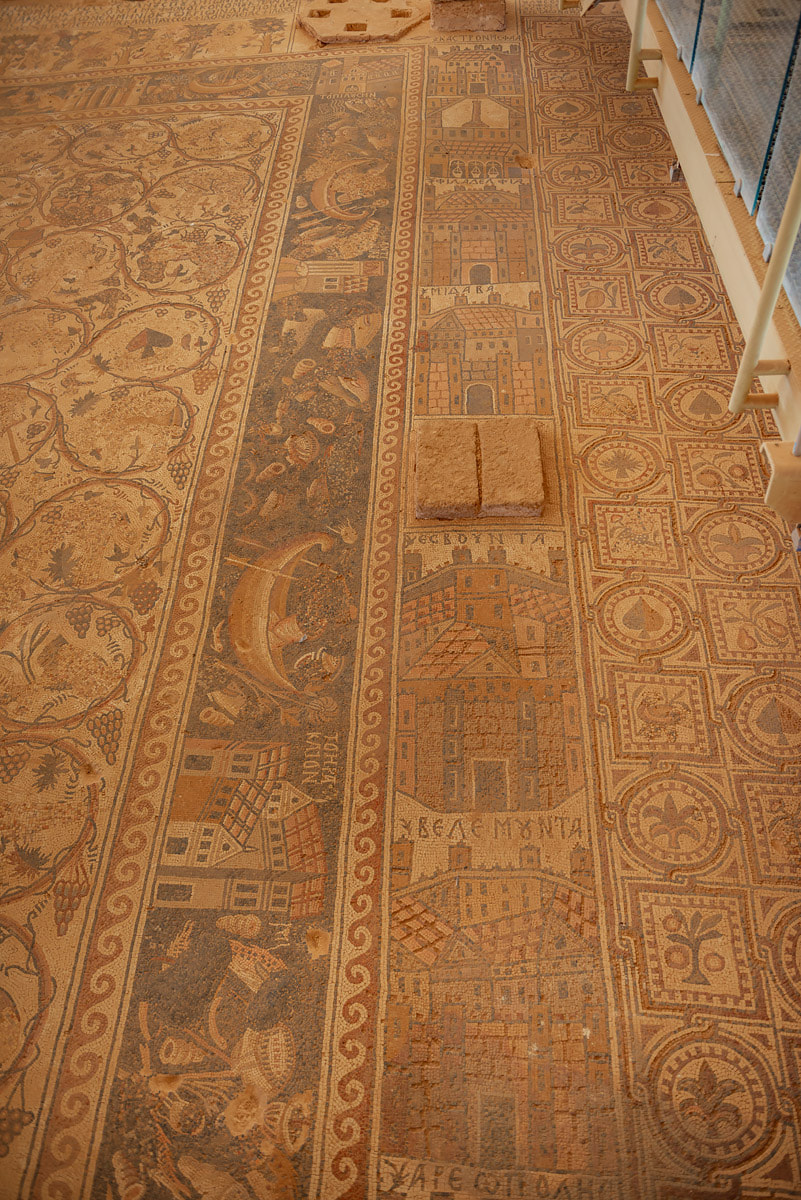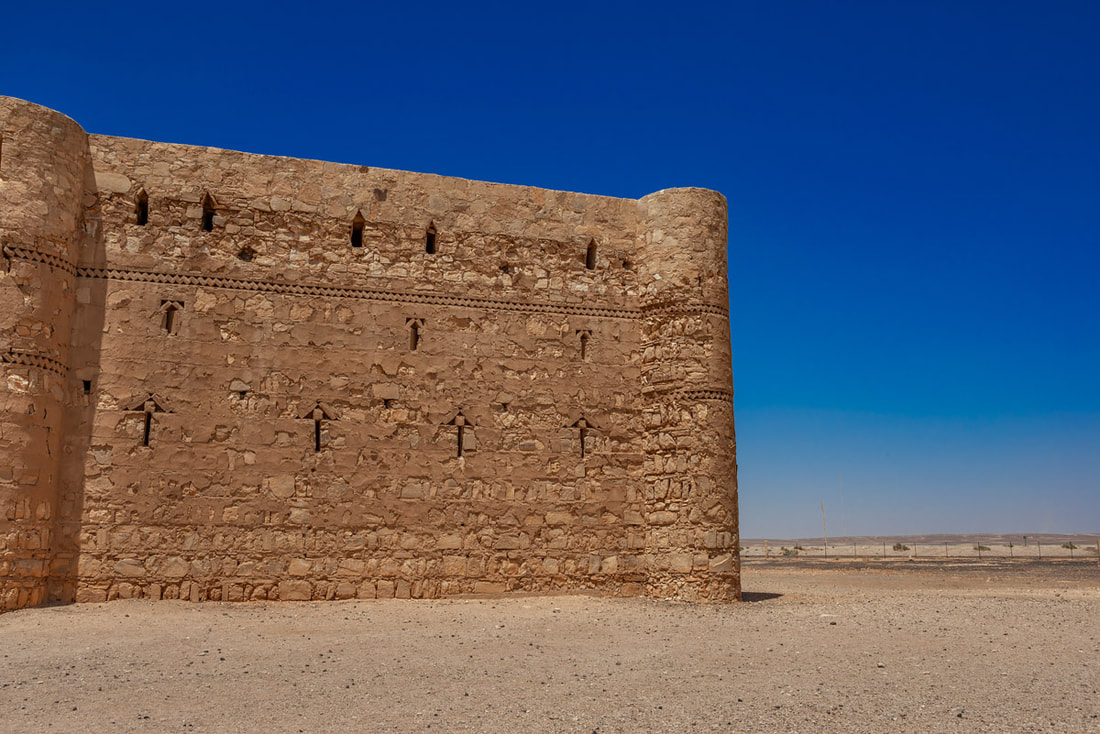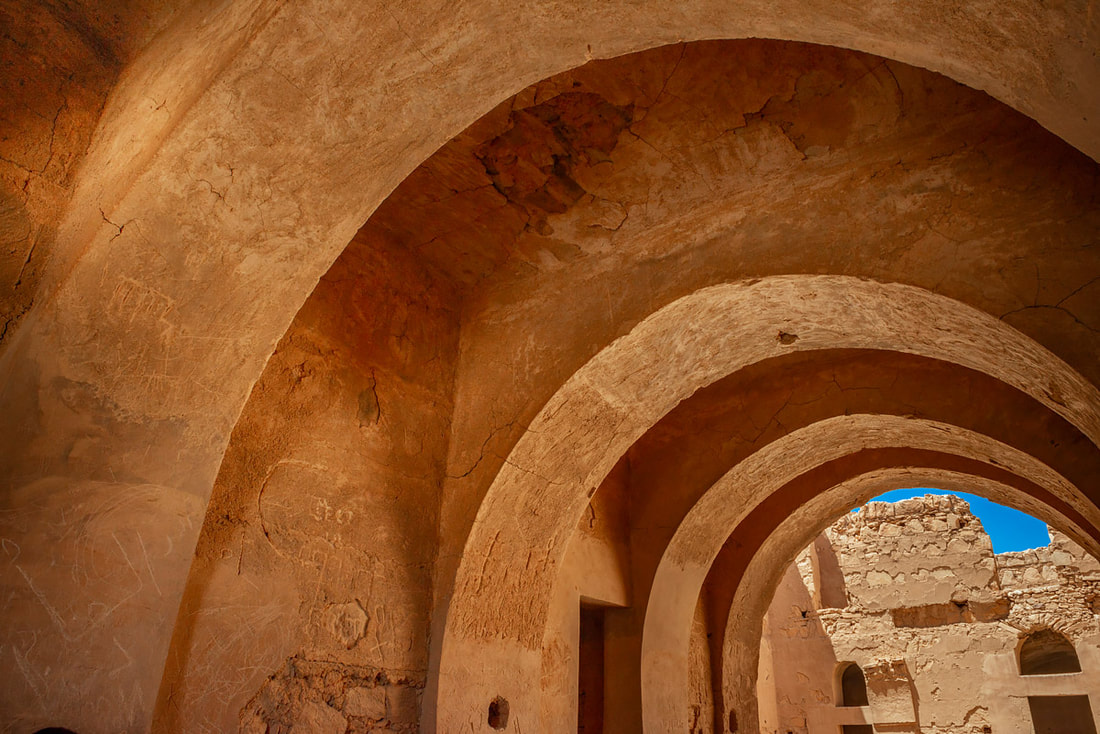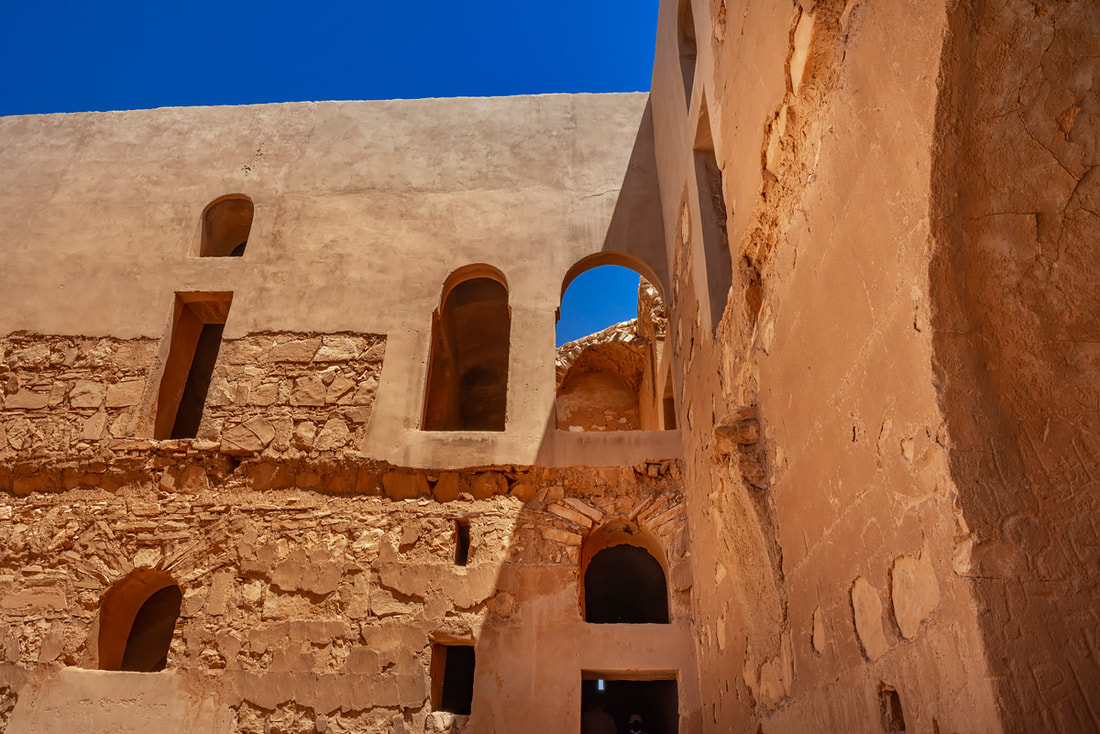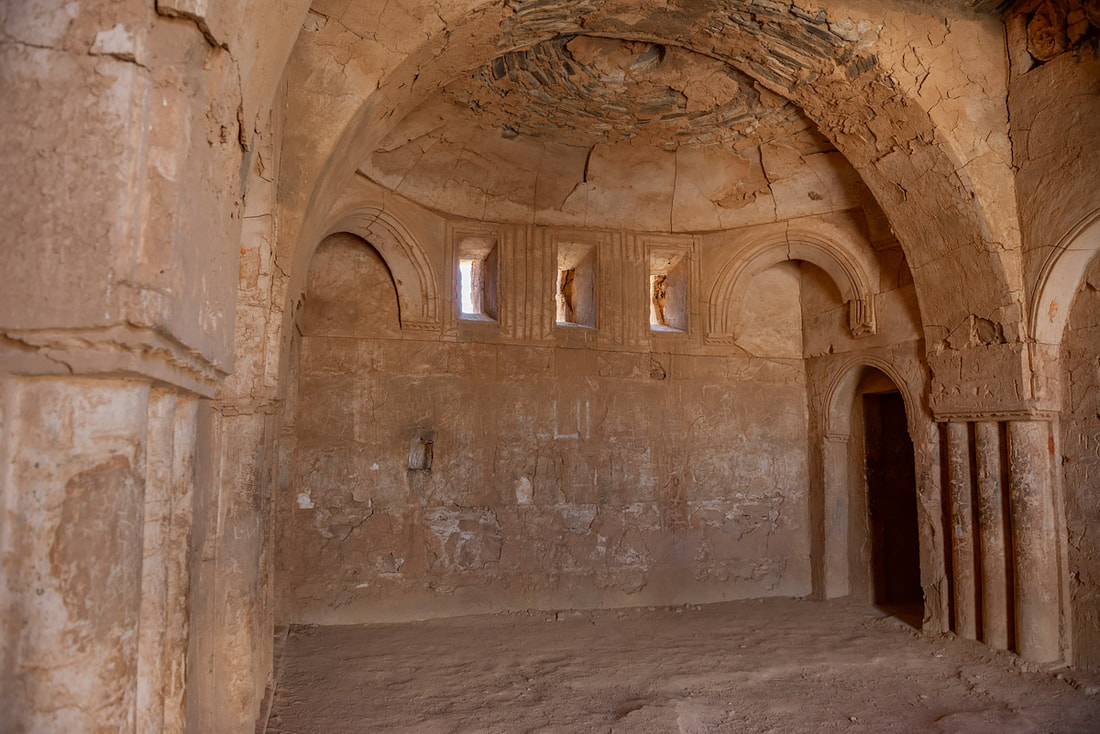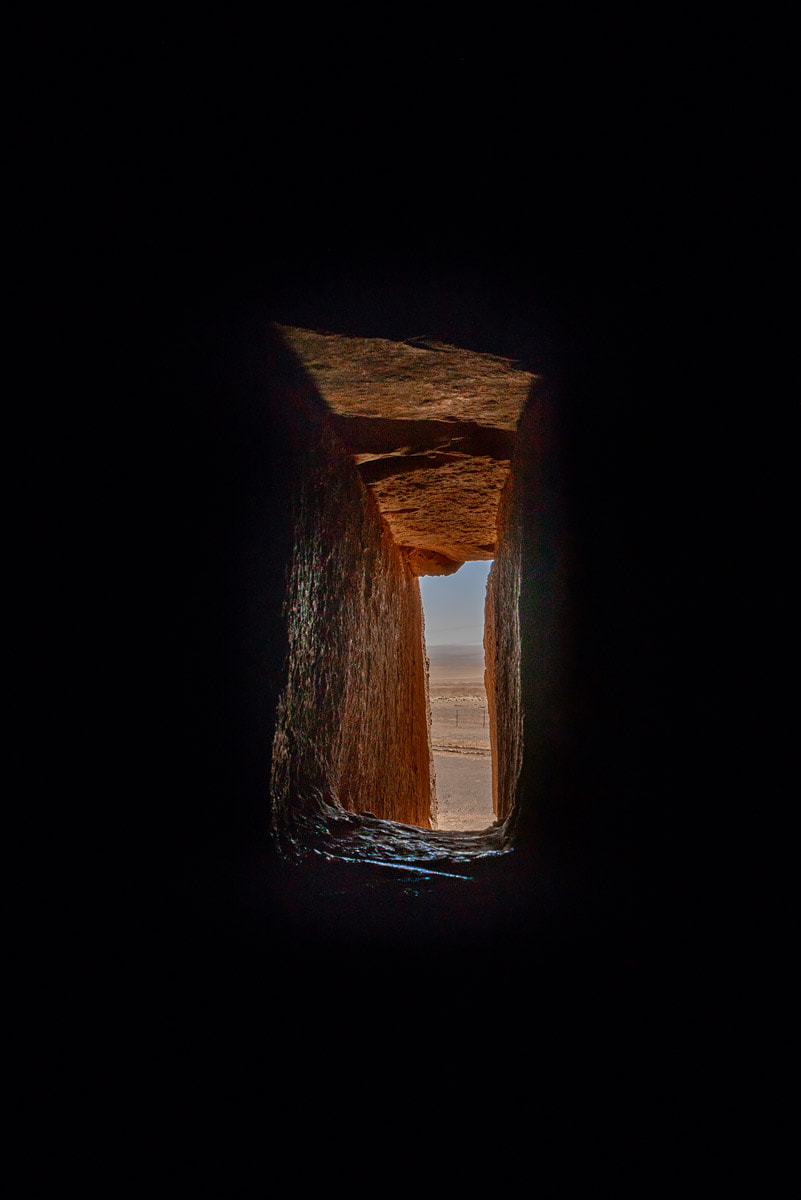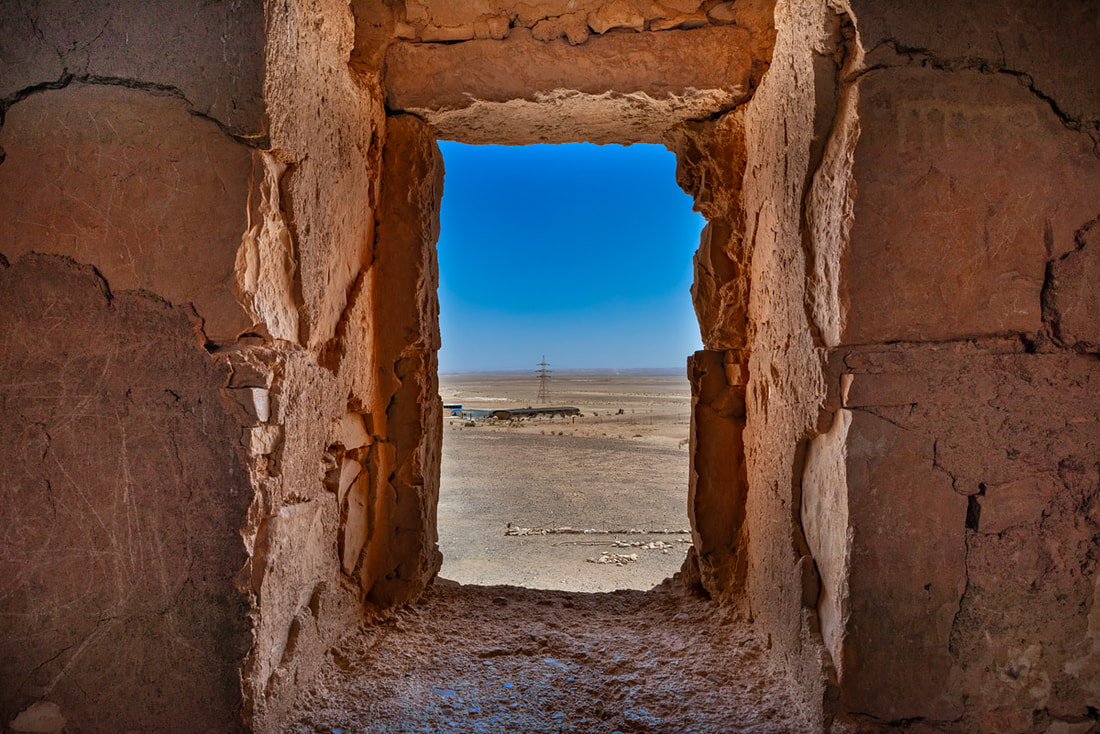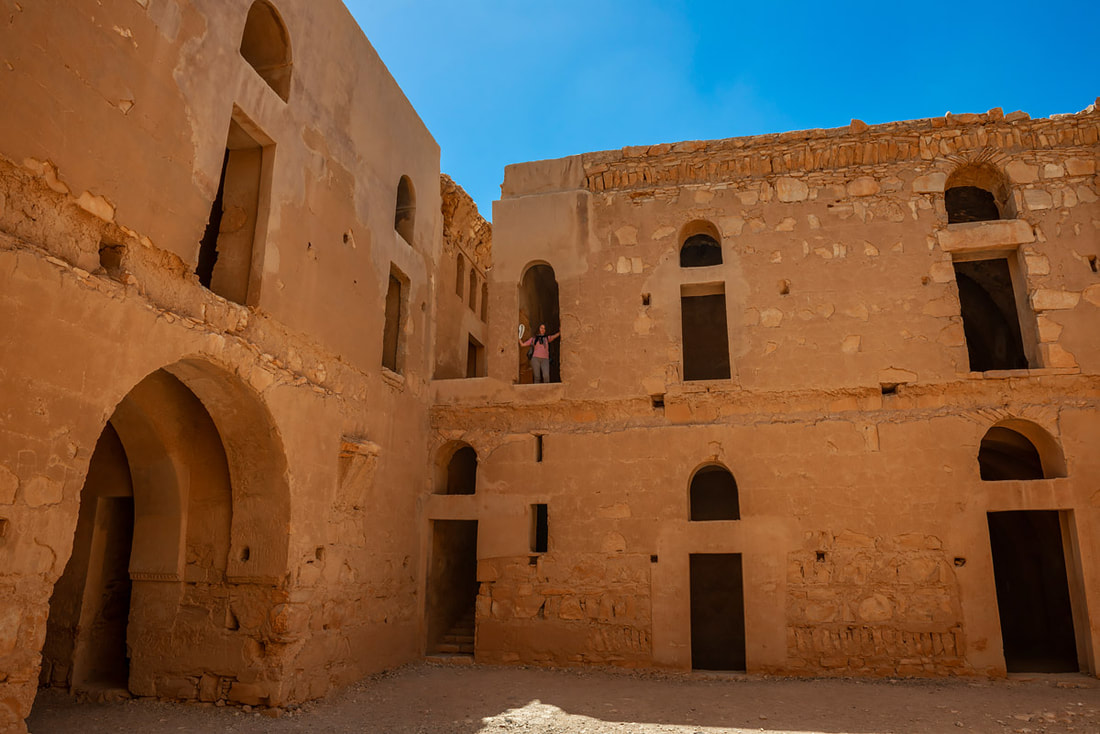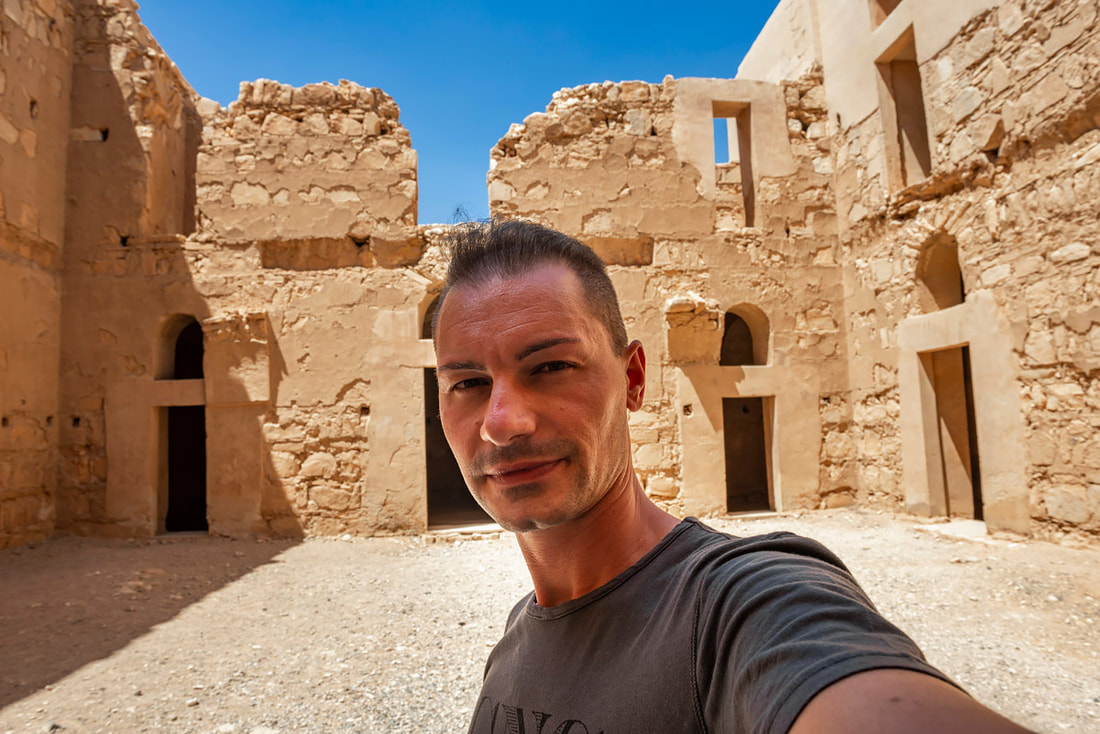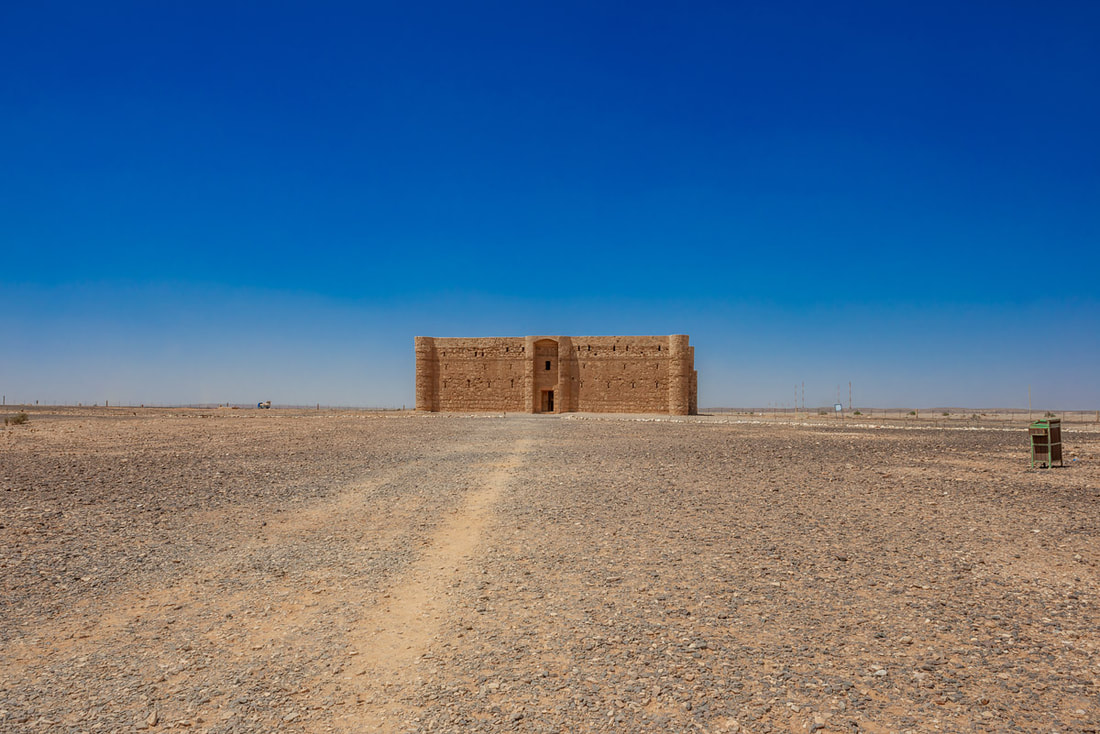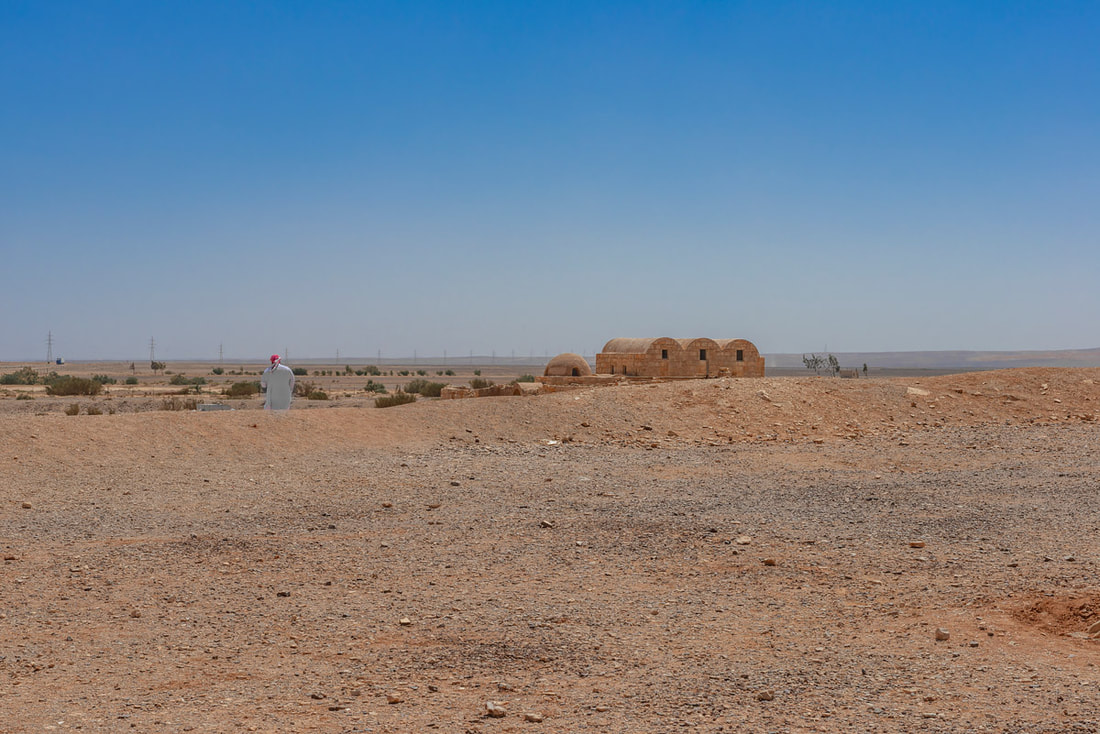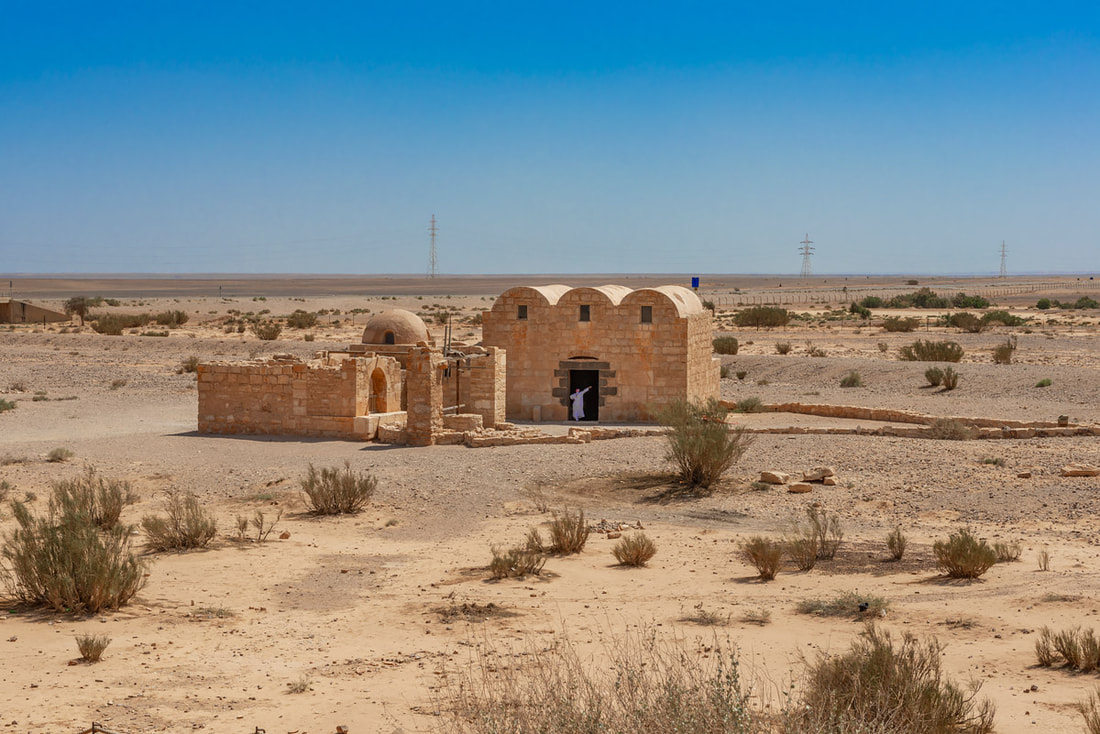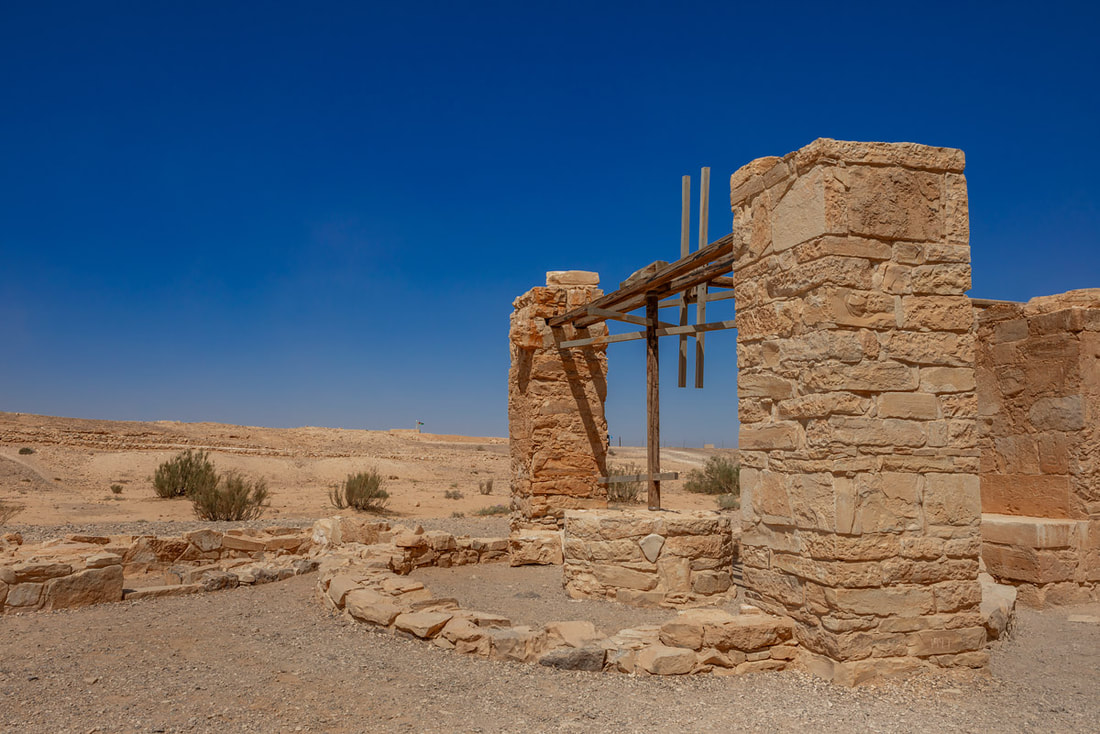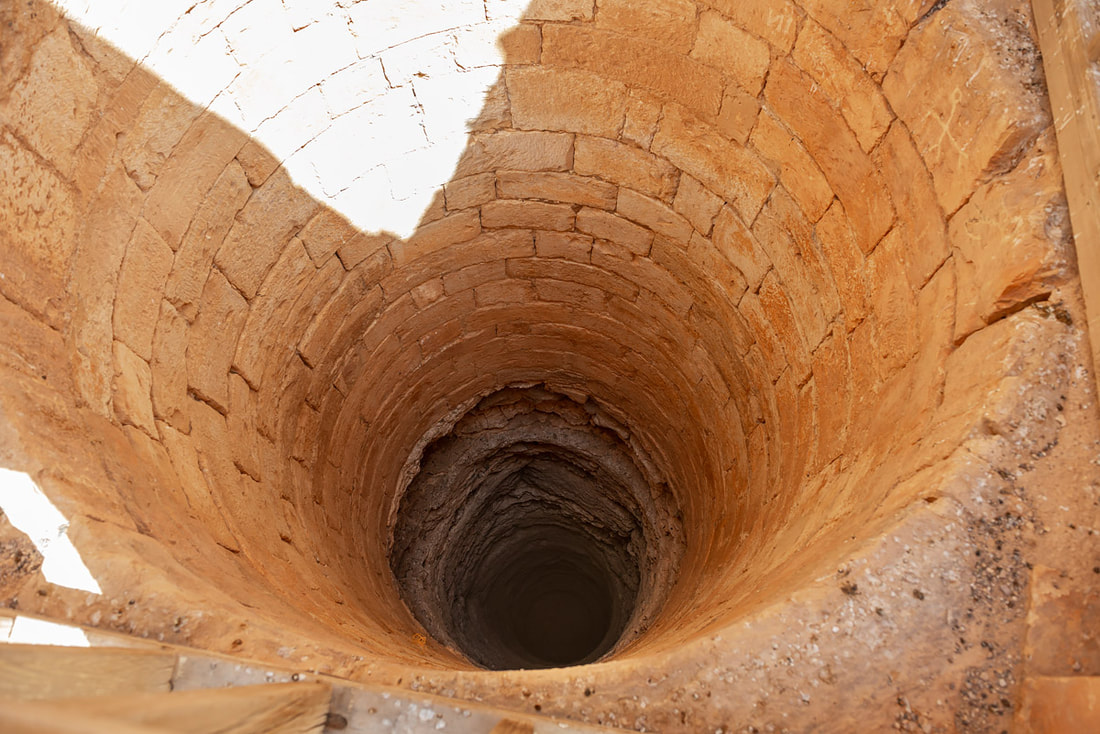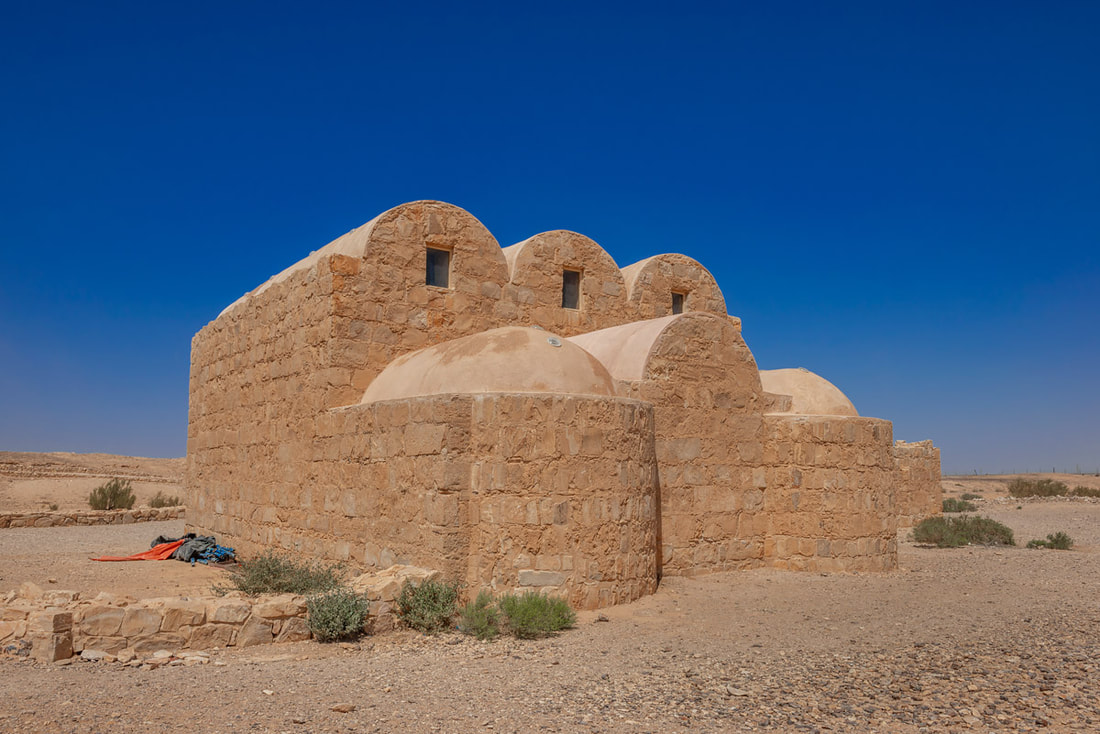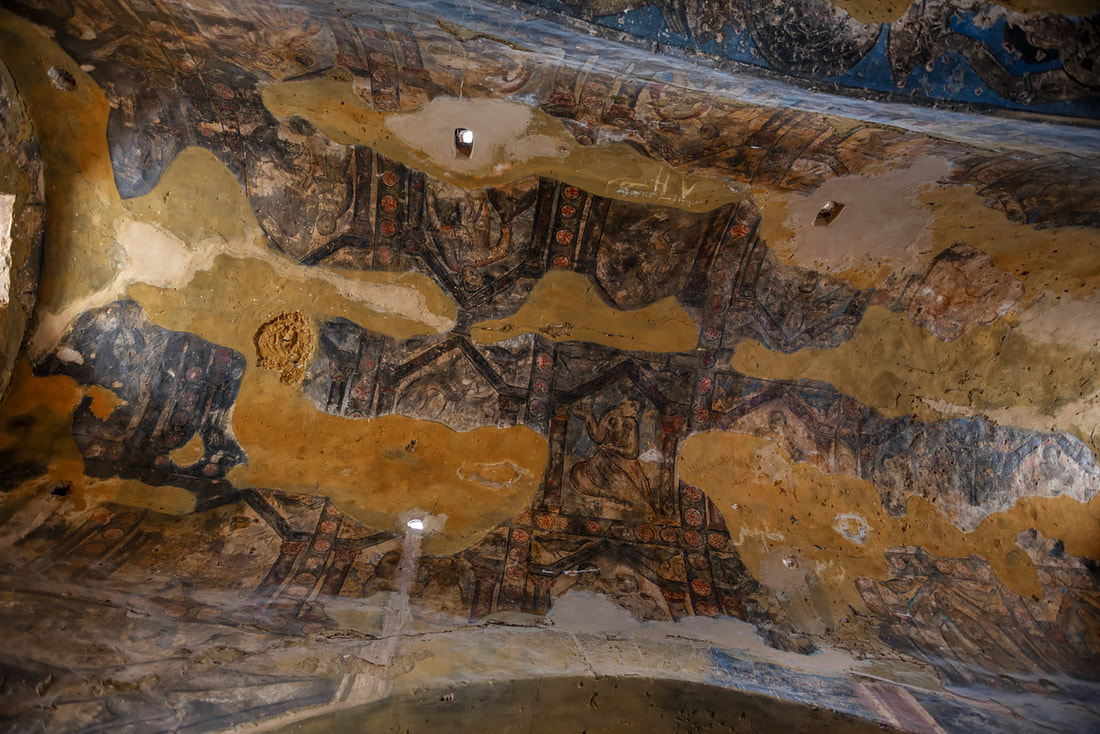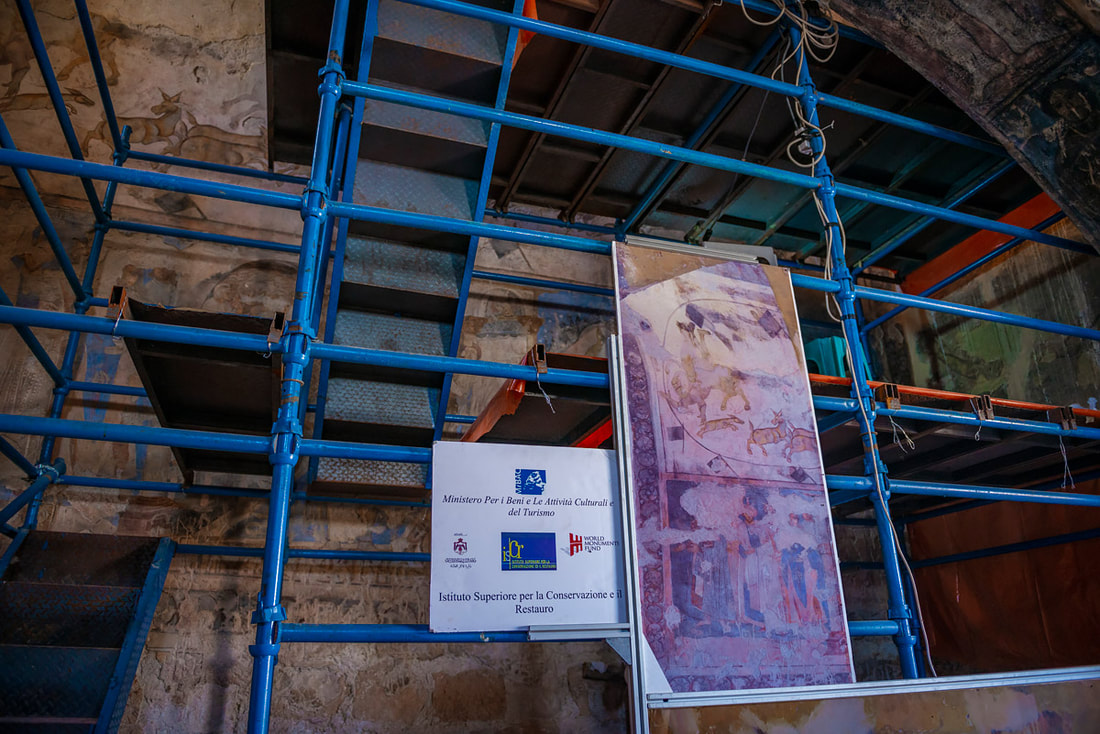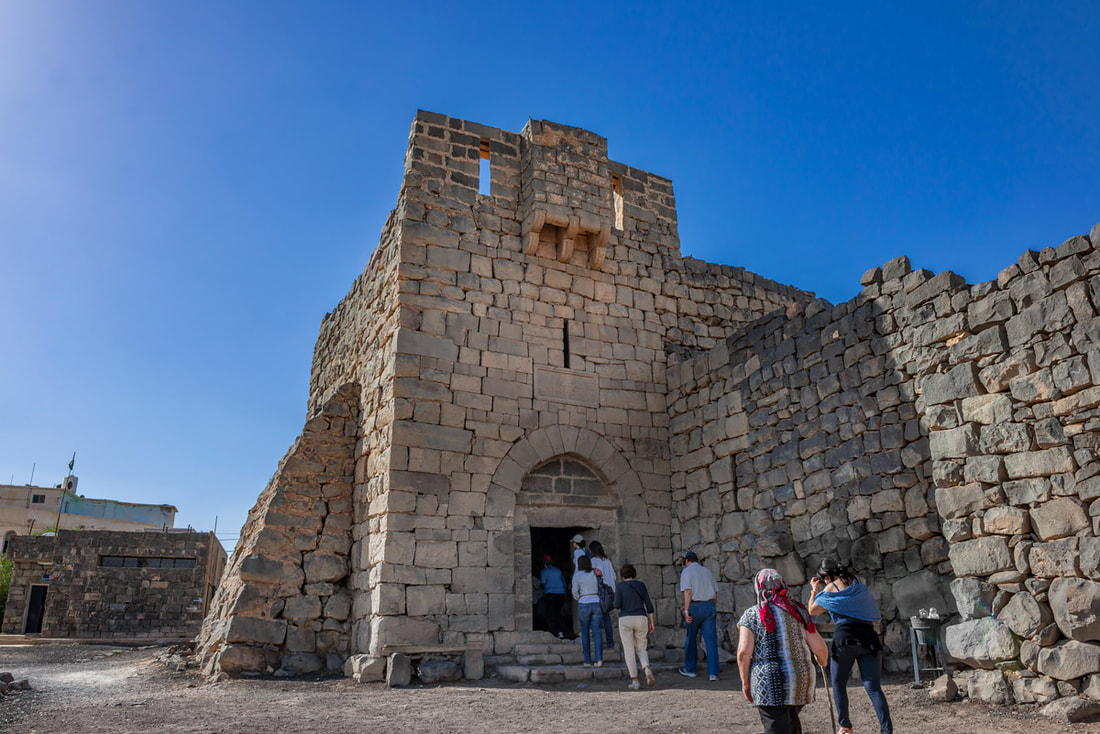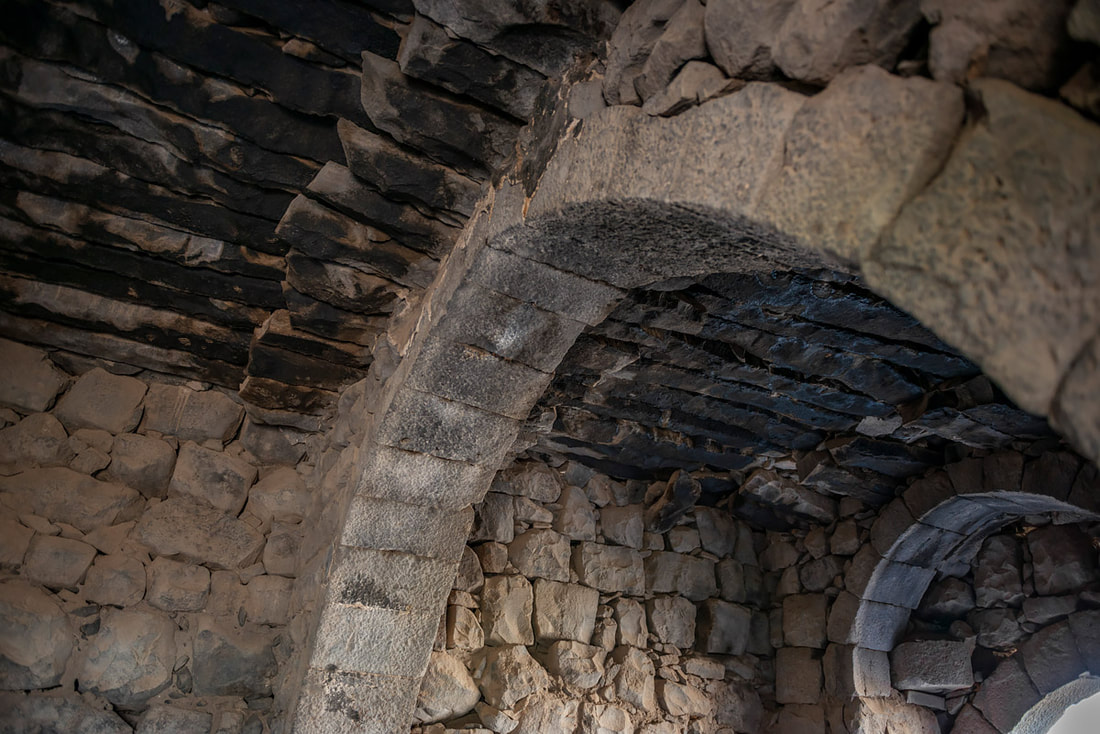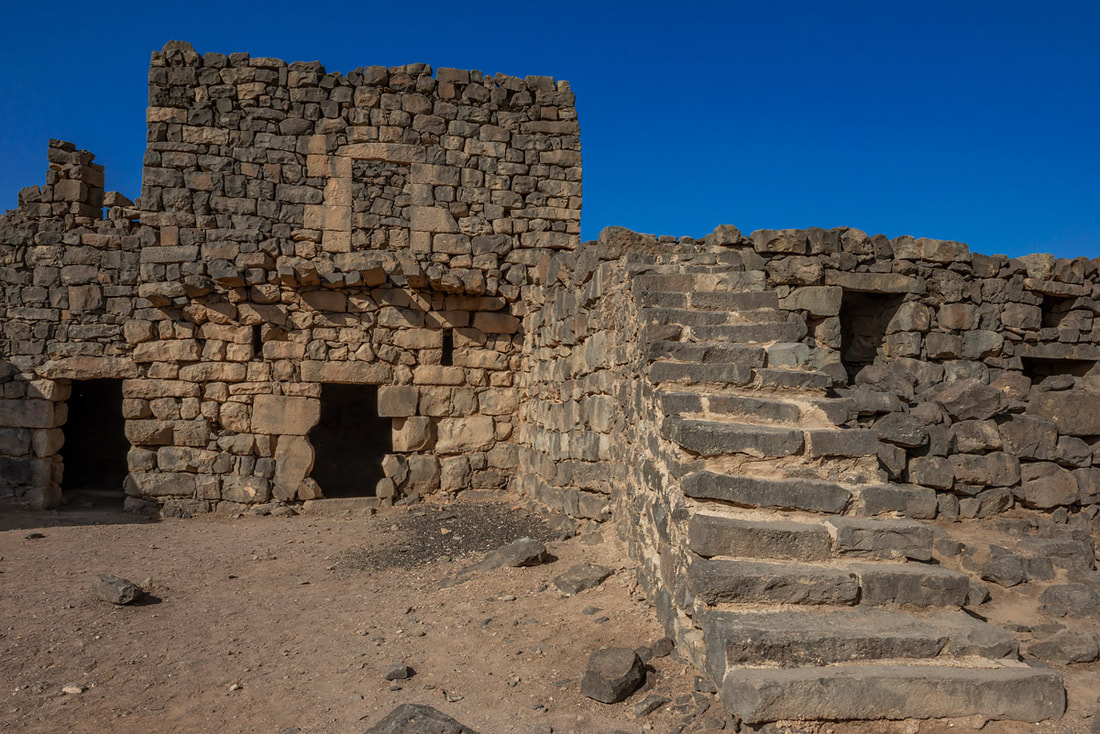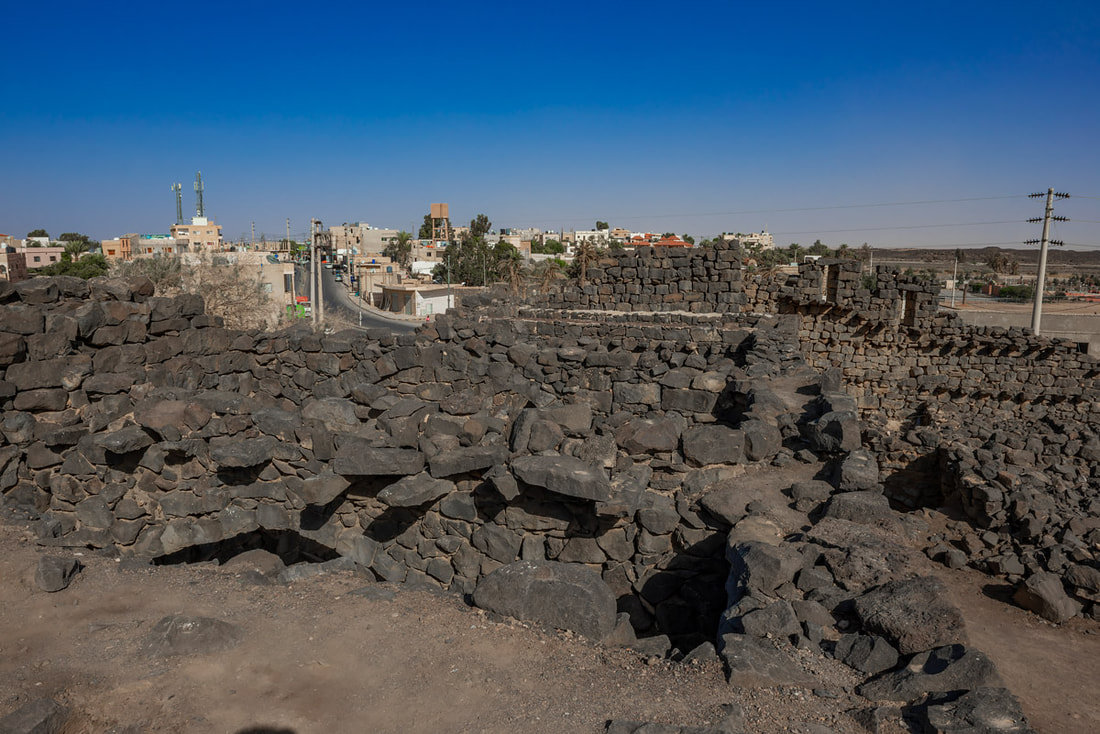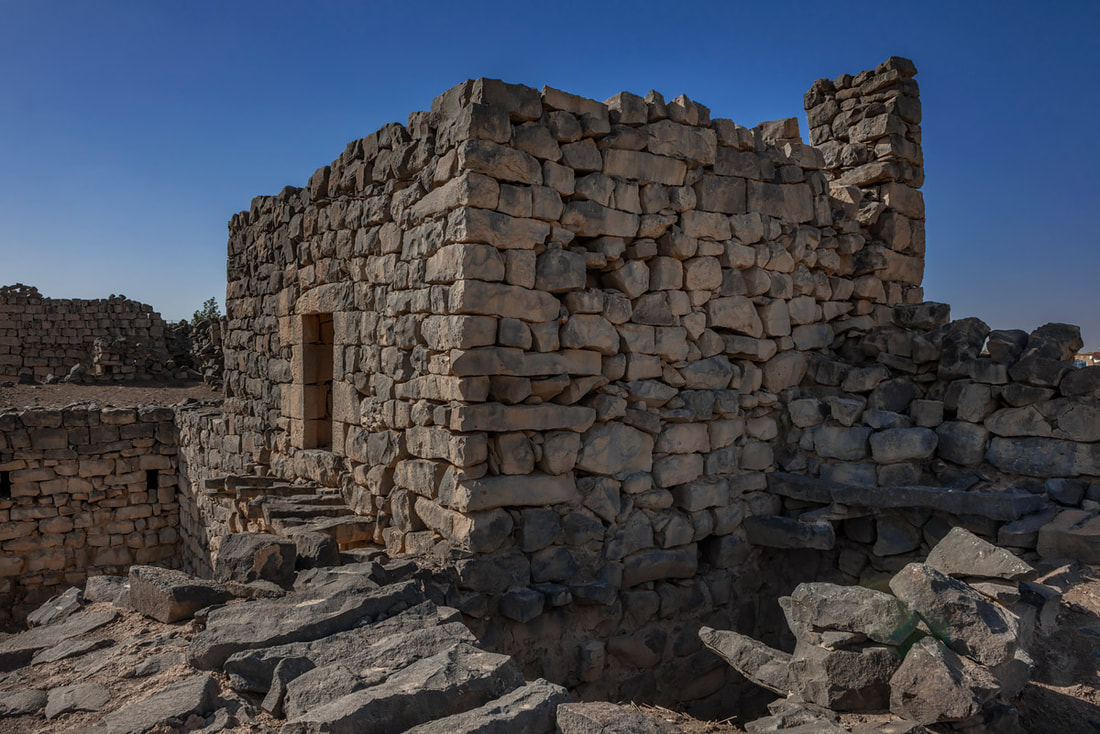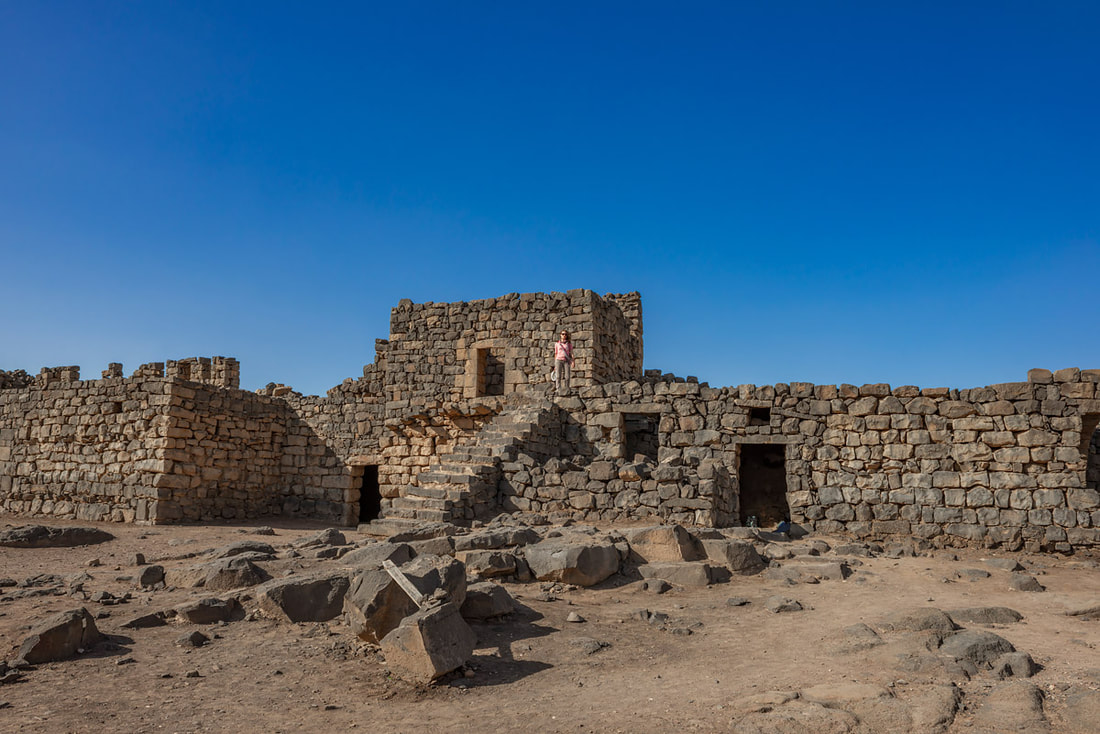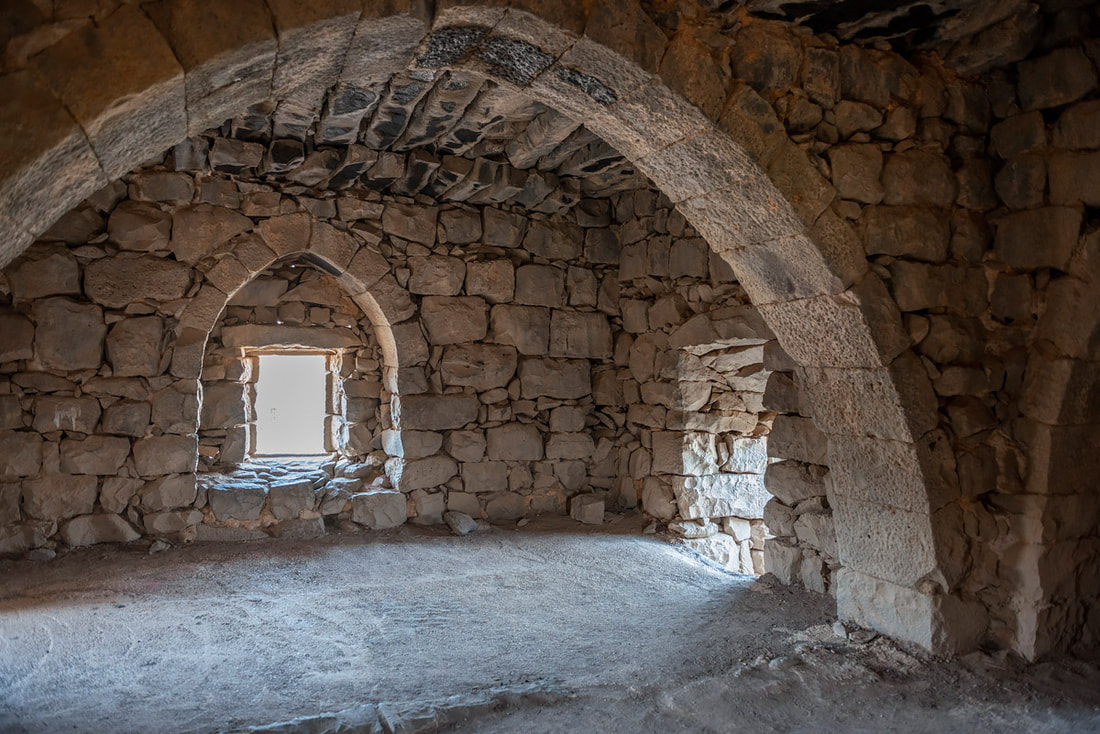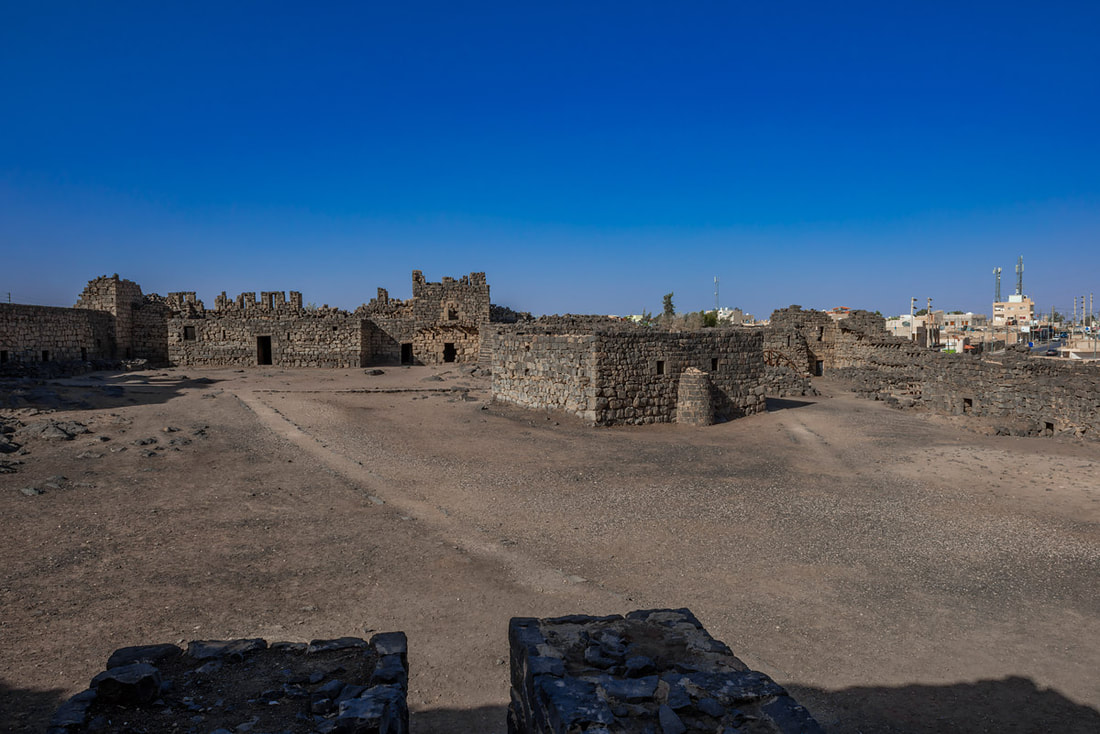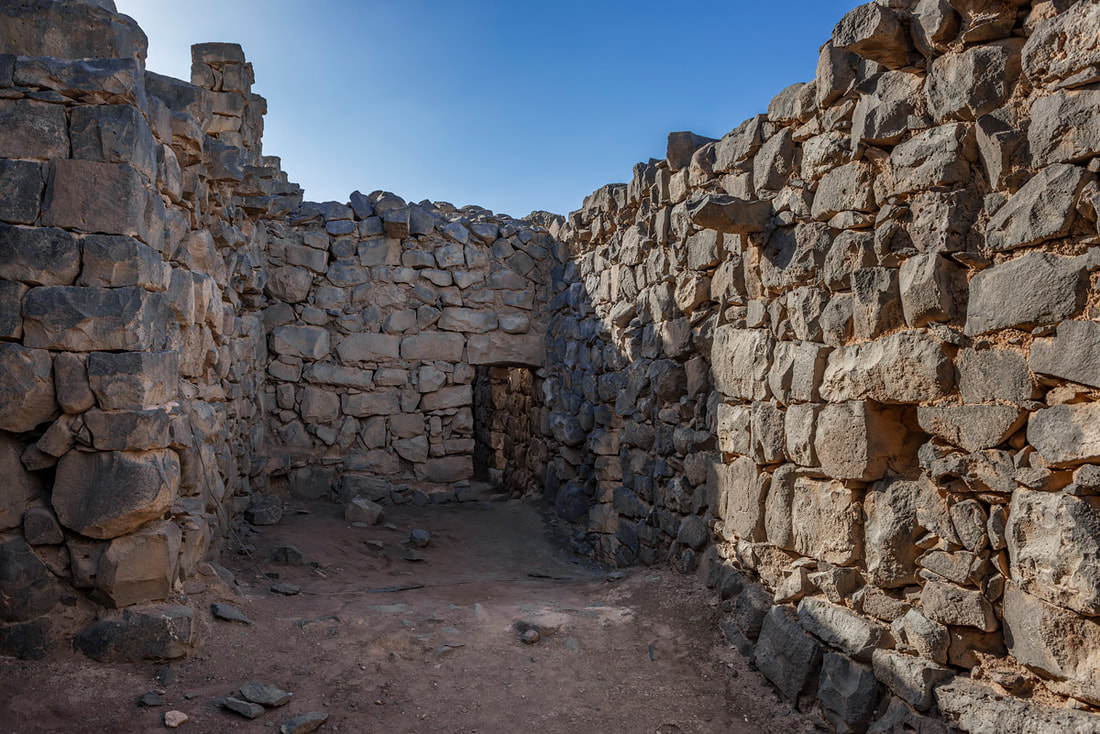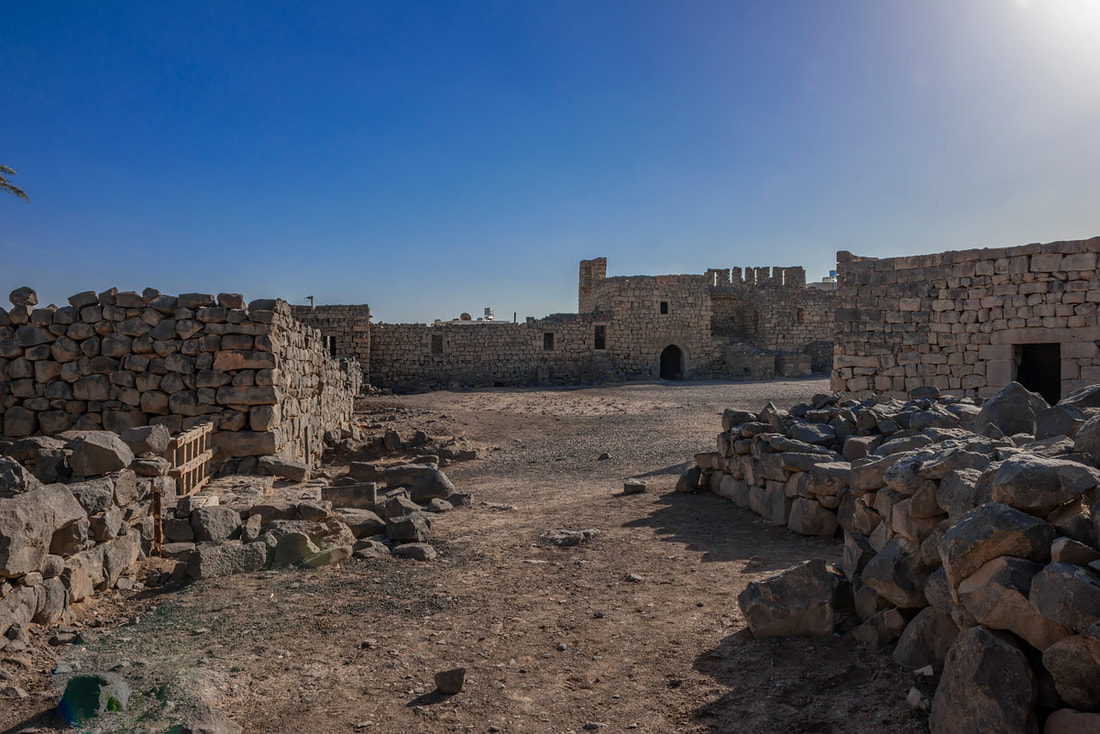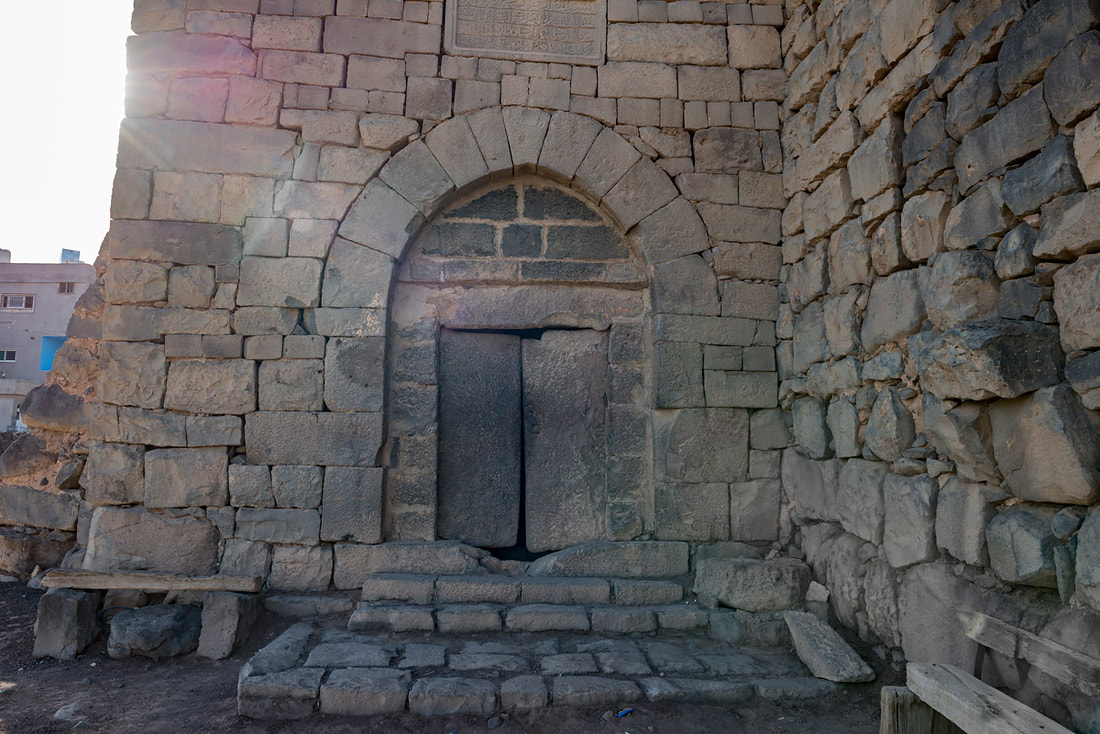By Antonio Malara Fifth chapter of my beautiful adventure in Jordan, the visit to the "Desert Castles" was originally planned after the visit to Amman but our guide has cleverly rescheduled it by inserting it after Wadi Rum. The evening before going to visit the castles we had slept in Petra and that morning began with a quick visit to the archaeological site of Umm al-Rasas. Probably tired from the previous day, that morning I was a bit disconnected. I had studied the “Desert Castle” and ready to visit them but I discovered that first we had to make a stop to see another site. In other words it meant that I was slightly sleepy and as a result I was carried away by events especially for that first visit. At about 10:20 AM, the bus stopped us in an area whose landscape was now familiar to us and which I liked very much, a desert and yellow place. Without knowing the details of the place, I immediately realized that it was an archaeological site given the presence of ruins scattered everywhere. What struck me immediately was the presence of many arches that surmounted the ancient walls. It was certainly what remained of much larger structures and those arches gave some life to a yellow plain where only the walls merged with the road. While walking, I saw a white shed in the distance, it was the structure we had to visit inside even though I had no idea what it housed. Shortly after I discovered that inside the shed there were very important mosaics, the structure was used to preserve them, in fact inside there were entire ruins of structures whose floors were all mosaics. There I found out that those ruins were actually part of Saint Steven Church. The idea of the structure was similar to the one we had seen in Madaba, an elevated walkway went around the structure allowing us to see the mosaics without stepping on them. What I remember about them is related to the photos I took that morning rather than my memories. I can say that some of the mosaics were very well preserved as I show in the photos. Our visit there lasted about half an hour and what impressed me was a reading by Don Valerio off the site and read on an iPhone. Back then (2014) it was unusual to use a telephone as a reading tool for a text, unfortunately I don't remember the content but only this detail. Umm al-Rasas Qasr al-Kharana The main Desert Castels were three: Qasr al-Kharana, Qusayr Amra and Qasr Azraq. That day we would visit them all and during the bus ride I started to “wake up” and get ready for what I thought was the important visit of the day. Two of these castles were built by the Umayyads and were more residences than fortresses, while the Qasr Azraq was built by the Romans. They represented the power of that people over the Bedouins, a way to demonstrate their superiority. I don't remember anything about moving from Umm al-Rasas to the first castle, we probably also stopped for lunch on the way. We arrived at Qasr al-Kharana around 1:20 PM and I was ready to document everything. The castle was beautiful from the outside; a yellow squared piece of stone in the middle of the desert land with a blue sky behind it. The walk to reach it lasted about five minutes and we saw this castle getting bigger and bigger as we got closer, given its position it was literally a castle in the desert. It was geometrically perfect in fact when I looked at it from the front it seemed two-dimensional, a flat wall, then moving to one side I could see its depth. Up close I saw narrow and long windows together with larger ones, from a distance they could not be seen because they merged with the design of the stone. At the entrance there was a very high wooden door and immediately after the structure was dominated by arched architecture. Immediately after the entrance there was access to a large internal courtyard. This was large and more or less squared in shape, the doors and windows overlooked it as they were both rectangular and also arch-shaped. We started exploring the castle and personally taking pictures. We also went upstairs but there was nothing inside, probably the most interesting thing had been looking from the windows-slits that gave on the outside, some of them were really small. Although beautiful, it gives the impression of a place that had been abandoned in a hurry or like when in science fiction movie, a population is kidnapped leaving nothingness in the cities. Another nice thing we did was to take pictures with my sister looking out the window, the perspective taken from the courtyard gave an idea of how big the place was. We left around 2 PM, it was a very short visit and as we returned to the bus I was convinced that the castle was impressive especially looking at it from the outside. In fact, on the way back I stopped several times to capture it with the camera. Qusayr Amra Qasayr Amra was not very far from the previous site in fact we arrived there after about 20 minutes. We got off the bus and walked briefly and the castle suddenly appeared from the top of the hill we were crossing. It was a nice way to see it because it was unexpected and sudden, I don't know if the guide had done it intentionally or that was the only way of access. Seeing it I felt like I was in Tatoonie outside Luke Skywalker's house because it was exactly what it looked like. In the midst of the desert scenery (ruined only by the presence of electric pylons), Quasayr Amra all in yellow stone was made up of two distinct parts, one had a dome while the other a triple arch-shaped roof. It was very small not only compared to Qasr al-Kharana but in general, the structure was not glitzy. Approaching I noticed the presence of a well, another separate structure also composed of two stone turrets that supported a wooden structure right above the well. Let's say that this castle, which is a UNESCO heritage site, was famous more for what was inside than for its architectural structure, which still had its charm. In fact, inside there were many frescoes, especially some of naked women taking a bath. I had studied this aspect of the castle so I was curious to see them. I must say that inside the castle respected the external proportions, in fact it was very small. However practically all the internal walls were full of frescoes, these were painted everywhere, on the walls, on the roofs and also in the parts of the arched structure. As subjects there was a bit of everything, from everyday life scenes to portraits with very large faces, battle scenes and then the famous naked women. Personally I have only seen one, the fresco was painted on an arch and was yellow on a blue background. Very large but it was a bit difficult to look at because the figure arched upwards. Unfortunately there was an entire wall that was covered by scaffolding due to the restoration. I don't know what paintings were there but the wall was very big so surely something interesting will have been there. The visit there lasted about 20 minutes, before getting on the bus I took the usual farewell photos with the castle in the background and we left for the last destination of the day. Qasr Azraq After about half an hour of travel while we were on the bus, our guide asked us for his attention. He slowed the bus down and showed us a singular intersection and its road signs. At that point, there was the possibility of taking three distinct roads, going straight we would have continued towards our destination, on the left we would arrive in Iraq while turning right we would arrive in Syria, whose border was only 15 minutes away by car. Overwhelmed by nostalgia, our guide told us about his youth, about the times when Syria was a safe place without war. He told us that it was normal for them to go to Damascus to have fun with friends. In fact, Syria was culturally freer from that point of view, so when they wanted to have a particular night in the clubs, they took the car and went to Syria. From what I understand, Damascus to them was like Las Vegas to American professionals who live flawlessly in their hometown and then shed their morals by going to the entertainment capital. We arrived at Qasr Azraq at about 4 PM, this castle was located near the town and we reached it immediately after getting off the bus. Outside the castle a sort of sign said that it had been built by the Romans then rebuilt by the Arabs and finally used by Lawrence. The reference was to the British writer Thomas Edward Lawrence who had lived there in that castle and had described his experience in "The Seven Pillars of Wisdom". Later the same adventure was made famous by the movie "Lawrence of Arabia". This fortress was built entirely of basalt stone so it had a dark, almost black color totally different from what we had seen in previous castles. The beauty and uniqueness of this stone was shown immediately from the entrance where a fairly large door was built of basalt. Personally I had never seen a stone door, that structure knew me of legends or fairy tales for children, I never thought of seeing one live. After entering, the guide explained to us how to get around and what to see, after which he lay down in a corner where there was a sort of handmade sofa and chatted with the guardian. After witnessing this scene, Don Valerio turned towards us exclaiming: "I told you, life is theirs". (Reference to the Arab culture where rushing things is an alien concept) Once we passed the entrance we were out again, the fort was very large formed by a rectangle of walls with various high buildings and a separate one in the center of the dirt ground. Everything was built with large blocks of black stone. I immediately saw by eye that there were parts that were completely intact and others that were more in ruins and therefore more dangerous to explore. The fact that the place had only one guardian who at that moment was lounging with our guide and that the fortress was completely wild and unprotected immediately thrilled me. I was in my natural habitat and after taking pictures of the site in general with my sister, I began my personal and solitary exploration. My concept of solitaire was not intended only "with myself" but extended to the fact of being alone even when I went to visit the single rooms. I don't know why but I didn't want to be disturbed, that place, even if in ruins, was something still alive for me. I mean that there had been a time when it was truly a castle populated by individuals so I wanted to evoke those feelings. This logic led me to visit the details when, in the individual points, there were no others from the group. I started exploring by climbing stone stairs, going down into the basements, then climbing into the half-destroyed parts trying to reach different perspectives. At one point I came across another stone door that separated two rooms and instinctively I wanted to try to see if it could be closed but I gave up. I enjoyed wandering on the dangerous terraces therefore not frequented by others and among many I found one that had two large holes that corresponded to the room below, even the roofs were built in stone. Turning around, I discovered that the building in the center, the isolated one, had a very particular staircase on one side. It was obviously made of stone but was simply made up of five to six long blocks of stone protruding from the completely flat wall. That staircase intrigued me and could give me access to a new terrace except that it was not easy to climb. More than anything else, balance was needed, which I couldn't have with the bulky camera with me. Not finding anyone to leave it to, I had to give up the idea and I sincerely regretted it strongly. I’m sure that if I return to that place there will be fences, many guardians and a closed access to that terrace. As I reached the room that I deliberately wanted to visit last, I looked around to understand where the sequences of "Lawrence of Arabia" were filmed, except for the walls, I didn’t find all the details present in the film, probably there was also part of sets and modifications prepared ad hoc. The room I last saw was the one that, if I am not mistaken, was given in honor of King (or Prince) Faisal. What I understood from the guide's speech was that the king in question had been very important in his life, so his room had to be treated the same way too. The room was located on an upper floor, if I remember correctly right above the entrance. It was very large with two arches and several windows as well as a view over the entire interior of the castle. In solitude and in the silence of that room I was able to concentrate and imagine everything the king had done in that place, trying to be an observer through an imaginary time machine. It was a very beautiful and relaxing moment, probably inspired by Don Valerio after the speech made on Machaerus. I enjoyed those moments and reluctantly left the room but it was time to leave. Soon after, I reunited with my sister and before leaving the place we took more farewell photos. We were the last to visit the castle that day, and after greetings from the guide to the guardian, the latter closed the stone door that really worked, like in a fairy tale. The return journey was very long and we arrived in Amman at around 8 PM. Despite the tiredness we had decided together with my sister and other girls of group to go out after dinner. We went to a place not far from our hotel and drank typical cocktails sitting at the tables outside, enjoying the mild evening and continuing to explore new cultures also from the night point of view. Pictures: Antonio Malara
Camera: Nikon D800
0 Comments
Leave a Reply. |






